Apple Varieties
These are apple varieties that have been tested
in a hot and humid climate and are very suitable for the tropics.
The qualities we look for are apples that stay crisp and juicy
during high heat, color up well despite hot nights, have some
disease resistance, have a very low chilling-hour requirement, and
keep well without refrigeration.
Some of these apples are from the American South, and others are traditional
favorites for the tropics that have been grown there for years.
Still others are cold-climate apples that have shown remarkable
adaptability to tropic conditions. All of them are better than
anything you have tasted in the market and will be a definite
improvement over what is commonly grown in the tropics.
Remember; it only takes one good apple that
performs well in an area to build an entire industry around; many
fortunes have been tied to an apple variety that markets well or can
be grown best only in a certain area. We recommend that you
try a wide variety to see what does best in your particular
location. We have an additional list
here.
See our
page regarding Anna and Dorsett Golden apples before ordering.
We are proud to offer many apple varieties
resistant to the main fungal diseases in Uganda, scab and powdery
mildew. When combined with good cultural practices,
these apples can eliminate the need to spray. They are also
excellent quality apples, desirable to growers even in regions where
fungal disease is not a problem.
☺Denotes a disease-resistant variety
|
|
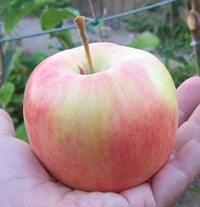 Anna Israel,
1959 Bred at Kibbutz Ein Shemer in Doar Na Shomron by Abba
Stein as a cross between the local cultivars Red Hadassiya (a
plum-sized apple) and Golden Delicious. Considered the
standard in low-chilling apples, Anna is Israel's gift to the world
as it feeds half the tropical world. The showy blossoms burst
fourth in late January and every blossom sets an apple (thin
heavily). Aggressive thinners will be rewarded with humongous,
beautiful apples blushed red and yellow. Anna must be
pollinated with Dorsett Golden or Shell of Alabama to get this size.
The flesh is white, crisp, sweet, juicy, with a hint of zing; it
makes excellent apple pies.
See our page regarding Anna. Anna Israel,
1959 Bred at Kibbutz Ein Shemer in Doar Na Shomron by Abba
Stein as a cross between the local cultivars Red Hadassiya (a
plum-sized apple) and Golden Delicious. Considered the
standard in low-chilling apples, Anna is Israel's gift to the world
as it feeds half the tropical world. The showy blossoms burst
fourth in late January and every blossom sets an apple (thin
heavily). Aggressive thinners will be rewarded with humongous,
beautiful apples blushed red and yellow. Anna must be
pollinated with Dorsett Golden or Shell of Alabama to get this size.
The flesh is white, crisp, sweet, juicy, with a hint of zing; it
makes excellent apple pies.
See our page regarding Anna. |
|
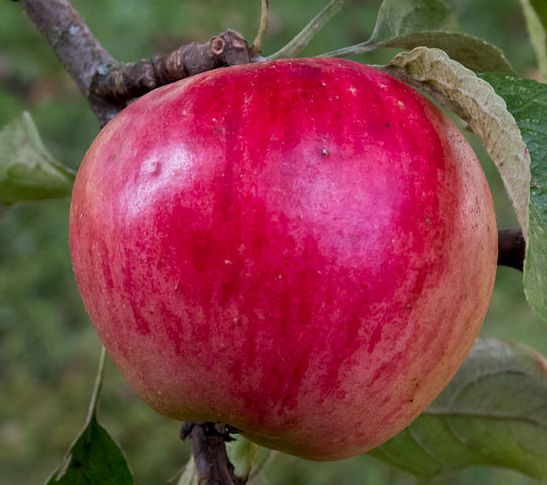
☺Akane
Japan, 1960ís
One of the better-tasting early varieties, a cross between Jonathan
and Worcester Pearmain. The medium-sized bright red apple has a
thin skin and white, crisp, juicy flesh with a hint of strawberry
flavor. Itís good for fresh eating, cooking, and drying, which is
good because it doesnít keep well. When cooked with the peels the
applesauce turns pink. It hangs well on the tree allowing extended
harvest time. It has good disease resistance.
|
|
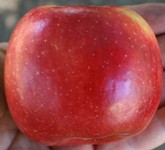 ☺Arkcharm
Arkansas, recent Developed by the University of
Arkansas (a very hot and humid part of the USA), Arkcharm keeps its
quality and colors up well despite high heat. It ripens
earlier in the season and has a good sugar/acid balance and complex
flavor. It has good disease resistance but does not keep very
long and should be eaten right away; it would be good for processing
into juice or dried apples if marketing takes more than a few days. ☺Arkcharm
Arkansas, recent Developed by the University of
Arkansas (a very hot and humid part of the USA), Arkcharm keeps its
quality and colors up well despite high heat. It ripens
earlier in the season and has a good sugar/acid balance and complex
flavor. It has good disease resistance but does not keep very
long and should be eaten right away; it would be good for processing
into juice or dried apples if marketing takes more than a few days. |
|
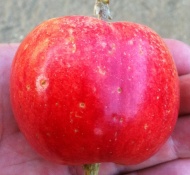 ☺Aunt
Rachel
North Carolina,
USA
Originated as local apple in
Chatham County,
North Carolina. Fruit begins ripening early in the season and continues for two to
three weeks. One of the best early season apples, Aunt Rachel is a
medium to large, red-striped apple covered with prominent light
dots. Very attractive with very fine flavor, good disease resistance. No catalog listing or
background was ever found, and so this may be a very rare seedling
apple grown only in a small part of the American South (until now). ☺Aunt
Rachel
North Carolina,
USA
Originated as local apple in
Chatham County,
North Carolina. Fruit begins ripening early in the season and continues for two to
three weeks. One of the best early season apples, Aunt Rachel is a
medium to large, red-striped apple covered with prominent light
dots. Very attractive with very fine flavor, good disease resistance. No catalog listing or
background was ever found, and so this may be a very rare seedling
apple grown only in a small part of the American South (until now). |
|
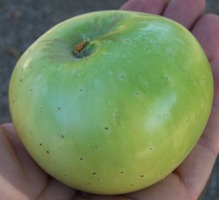 ☺Bramley
England, 1800 Bramley is the national cooking apple of
England and many will find it odd for it to be on this list, but it
has proven to be very reliable in a tropic climate. It is very
vigorous (the original 200-year-old tree is still growing and
bearing apples in Nottingham) and annual bearing. It is quite
tart until completely ripe and makes an applesauce that will about
blow your head off with an intense flavor. Resistant to scab
and powdery mildew. For an apple from
such a cool climate it sure is not bothered by the heat any,
tolerating 45 C. with no problems. ☺Bramley
England, 1800 Bramley is the national cooking apple of
England and many will find it odd for it to be on this list, but it
has proven to be very reliable in a tropic climate. It is very
vigorous (the original 200-year-old tree is still growing and
bearing apples in Nottingham) and annual bearing. It is quite
tart until completely ripe and makes an applesauce that will about
blow your head off with an intense flavor. Resistant to scab
and powdery mildew. For an apple from
such a cool climate it sure is not bothered by the heat any,
tolerating 45 C. with no problems. |
|
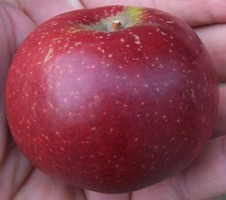 Dixie
Red Delight
Alabama, 1960ís A sport of Red
Delight of the early 1900's, Dixie Red Delight was developed by
an amateur horticulturist, Oren T. Bolding, of Sylacauga, Alabama.
Fruit is medium to large, with red skin and yellow ground color.
Flavor is sharp, sweet, aromatic, and spicy, and improves in
storage; the closest thing to Virginia Winesap we've tasted in a hot
climate. Keeps well and improves in storage, bears heavily and
reliably, ripens late in the season and blooms late. Dixie
Red Delight
Alabama, 1960ís A sport of Red
Delight of the early 1900's, Dixie Red Delight was developed by
an amateur horticulturist, Oren T. Bolding, of Sylacauga, Alabama.
Fruit is medium to large, with red skin and yellow ground color.
Flavor is sharp, sweet, aromatic, and spicy, and improves in
storage; the closest thing to Virginia Winesap we've tasted in a hot
climate. Keeps well and improves in storage, bears heavily and
reliably, ripens late in the season and blooms late.
|
|
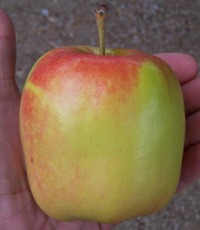 Dorset Golden
Bahamas, 1954
Bred by Mrs. I. Dorsett in Nassau as a chance seedling of Golden
Delicious. The best pollinator for Anna and an excellent apple
in it's own right, as it will grow anywhere and produces the year
after planting. Like Anna it can be coaxed to bear two crops per
year. Crunchy, juicy, sweet-tart with classic apple flavor. Good
fresh, in pies, and for cider. They start to fall off the tree when
ripe, and the flavor is best when just a little green still.
Thin hard to obtain huge apples. When pollinated correctly
with Anna the apples have a distinct "blockish" shape. They
bruise easily. See our
page regarding Anna and Dorsett Golden Dorset Golden
Bahamas, 1954
Bred by Mrs. I. Dorsett in Nassau as a chance seedling of Golden
Delicious. The best pollinator for Anna and an excellent apple
in it's own right, as it will grow anywhere and produces the year
after planting. Like Anna it can be coaxed to bear two crops per
year. Crunchy, juicy, sweet-tart with classic apple flavor. Good
fresh, in pies, and for cider. They start to fall off the tree when
ripe, and the flavor is best when just a little green still.
Thin hard to obtain huge apples. When pollinated correctly
with Anna the apples have a distinct "blockish" shape. They
bruise easily. See our
page regarding Anna and Dorsett Golden |
|
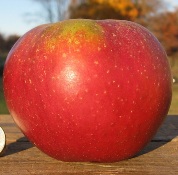 ☺Dula's
Beauty
North Carolina, USA late 1800's Originated from seeds of a
Limbertwig planted by J. A. Dula of Lenoir, North Carolina. It
is a strong, vigorous tree well adapted to all growing conditions.
In 1908, the NC Dept. of Agriculture recommended this variety for
lowland coastal growers (a very warm climate). Fruit is large and
slightly conical with dark-red skin overlaid with darker red
stripes. Flesh is yellowish-white, tender, crisp and juicy. Ripens
late fall to early winter, good disease resistance. ☺Dula's
Beauty
North Carolina, USA late 1800's Originated from seeds of a
Limbertwig planted by J. A. Dula of Lenoir, North Carolina. It
is a strong, vigorous tree well adapted to all growing conditions.
In 1908, the NC Dept. of Agriculture recommended this variety for
lowland coastal growers (a very warm climate). Fruit is large and
slightly conical with dark-red skin overlaid with darker red
stripes. Flesh is yellowish-white, tender, crisp and juicy. Ripens
late fall to early winter, good disease resistance. |
|
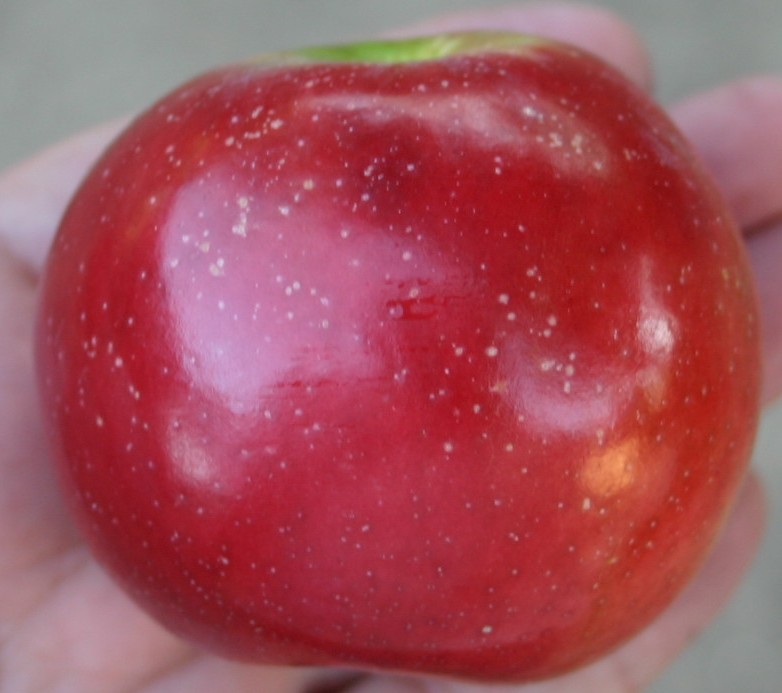 ☺Enterprise
Indiana, USA, 1982 A product of the Purdue, Rutgers,
University of Illinois (PRI) breeding program, Enterprise is a
reliable, late-maturing apple that is immune to scab and resistant
to powdery mildew. The apples have a waxy "bloom" that
polishes off to a high shine, showing off the fire-engine red skin.
The flesh is very firm and juicy, with a good complex flavor.
The tree tends to over-bear crops of smaller apples, and so thinning
heavily is necessary to achieve good size. The apples drop off
the tree when ripe. ☺Enterprise
Indiana, USA, 1982 A product of the Purdue, Rutgers,
University of Illinois (PRI) breeding program, Enterprise is a
reliable, late-maturing apple that is immune to scab and resistant
to powdery mildew. The apples have a waxy "bloom" that
polishes off to a high shine, showing off the fire-engine red skin.
The flesh is very firm and juicy, with a good complex flavor.
The tree tends to over-bear crops of smaller apples, and so thinning
heavily is necessary to achieve good size. The apples drop off
the tree when ripe. |
|
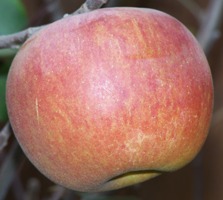 Fuji
Japan, 1962 Despite its commercial success,
few people have tasted Fuji as it was meant to be, which is sweet,
flavorful, crunchy, and ridiculously juicy. This is because it
requires a long, hot season to pump the full quota
of sugar and flavor into the orangish yellow flesh. Just because the
skin has colored up doesn't mean it is ripe, although the skin never
does really color up well. Fuji takes about 5 years to start
producing, but reliably sets a full crop every year after that; thin
hard and you'll get huge apples. Ripens late and keeps extremely well,
self-fertile. A mandatory apple for all areas; it is that good. Fuji
Japan, 1962 Despite its commercial success,
few people have tasted Fuji as it was meant to be, which is sweet,
flavorful, crunchy, and ridiculously juicy. This is because it
requires a long, hot season to pump the full quota
of sugar and flavor into the orangish yellow flesh. Just because the
skin has colored up doesn't mean it is ripe, although the skin never
does really color up well. Fuji takes about 5 years to start
producing, but reliably sets a full crop every year after that; thin
hard and you'll get huge apples. Ripens late and keeps extremely well,
self-fertile. A mandatory apple for all areas; it is that good. |
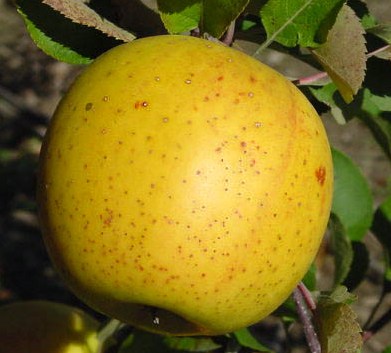 ☺GoldRush
Illinois, 1972 Another
product of the PRI disease-resistant breeding
program, GoldRush is immune to scab and highly resistant to powdery
mildew. It is rated tops in both flavor and keeping abilities,
and is said to actually improve in storage. We have found the
tree to be productive and well-adapted to a warm climate. The
crisp, juicy flesh is like a cross between Fuji and Winesap, having
a complexity to go along with high levels of sugar and acid. ☺GoldRush
Illinois, 1972 Another
product of the PRI disease-resistant breeding
program, GoldRush is immune to scab and highly resistant to powdery
mildew. It is rated tops in both flavor and keeping abilities,
and is said to actually improve in storage. We have found the
tree to be productive and well-adapted to a warm climate. The
crisp, juicy flesh is like a cross between Fuji and Winesap, having
a complexity to go along with high levels of sugar and acid. |
|
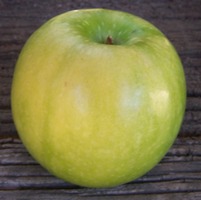 Granny
Smith Australia, 1868
Sprouted from a washtub of French crab apple trimmings tossed out by
an actual granny, Maria Anne Smith of the Ryde District of New South
Wales, Australia. You may be surprised if you're expecting the
homogenous, lime-green coloring like in the market, as when ripe
Granny Smith has a pinkish-orange blush on the sunny side. It
needs a long, hot season to attain the best flavor, and makes
excellent pies. The tree requires very little care. Granny
Smith Australia, 1868
Sprouted from a washtub of French crab apple trimmings tossed out by
an actual granny, Maria Anne Smith of the Ryde District of New South
Wales, Australia. You may be surprised if you're expecting the
homogenous, lime-green coloring like in the market, as when ripe
Granny Smith has a pinkish-orange blush on the sunny side. It
needs a long, hot season to attain the best flavor, and makes
excellent pies. The tree requires very little care. |
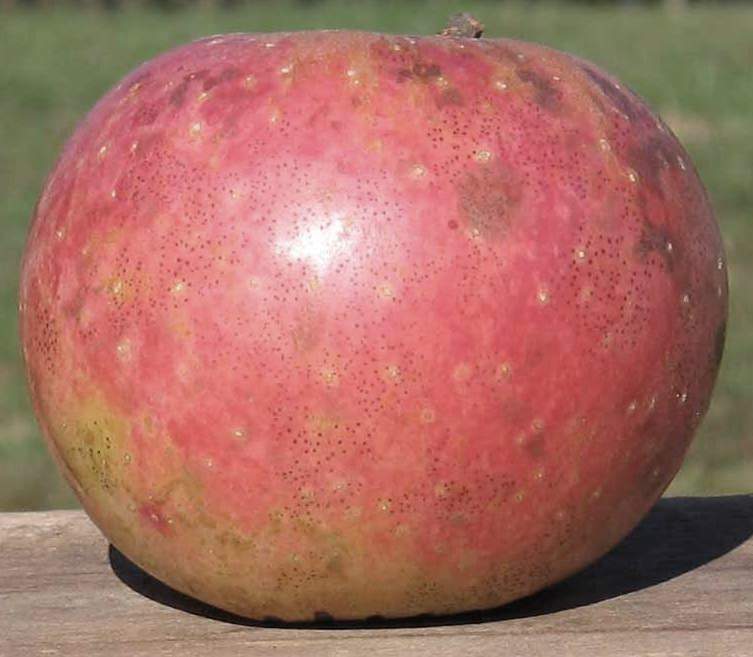 Hunge
North Carolina, 1700's A vigorous grower,
well-adapted to zero-chill warm climates in East Africa. The
crisp, juicy flesh is intensely sweet-tart, overwhelming at first,
but becoming more tolerable on the second bite with a winey flavor.
It is also excellent dried and cooked. Ripens mid-season,
about 6-8 weeks after Anna. Hunge
North Carolina, 1700's A vigorous grower,
well-adapted to zero-chill warm climates in East Africa. The
crisp, juicy flesh is intensely sweet-tart, overwhelming at first,
but becoming more tolerable on the second bite with a winey flavor.
It is also excellent dried and cooked. Ripens mid-season,
about 6-8 weeks after Anna. |
|
 ☺King
David Arkansas, 1893
This turned out to be one of our favorite apples, and for good
reason; it was Stark Bros. Nursery's biggest producer for years and
considered tops in flavor in warm climates, proving itself very
adaptable. The apples are very hard until ripe and are
somewhat insect-resistant. It turns deep
purple, almost black and hangs late on the tree and should be picked when full color
develops. Yellow flesh, firm, crisp and juicy with a deep, dark, rich winey
flavor that matches the color, a favorite with most people who try
it. ☺King
David Arkansas, 1893
This turned out to be one of our favorite apples, and for good
reason; it was Stark Bros. Nursery's biggest producer for years and
considered tops in flavor in warm climates, proving itself very
adaptable. The apples are very hard until ripe and are
somewhat insect-resistant. It turns deep
purple, almost black and hangs late on the tree and should be picked when full color
develops. Yellow flesh, firm, crisp and juicy with a deep, dark, rich winey
flavor that matches the color, a favorite with most people who try
it. |
|
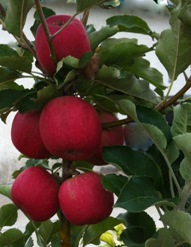 Lady Williams
Australia, 1935 A Granny Smith offspring
that is also a parent of Pink Lady. A pinkish-red apple with a
distinctive horizontal white stripe on one side that ripens very
late and needs a long hot season, usually ripening two months later than
most other apples.
It is quite tart until fully ripe, when it developed a nice sweet/tart
balance. So far it has out-produced its offspring Cripp's Pink (aka
Pink Lady) and is grown in the jungles of Malaysia with good
success. Lady Williams
Australia, 1935 A Granny Smith offspring
that is also a parent of Pink Lady. A pinkish-red apple with a
distinctive horizontal white stripe on one side that ripens very
late and needs a long hot season, usually ripening two months later than
most other apples.
It is quite tart until fully ripe, when it developed a nice sweet/tart
balance. So far it has out-produced its offspring Cripp's Pink (aka
Pink Lady) and is grown in the jungles of Malaysia with good
success. |
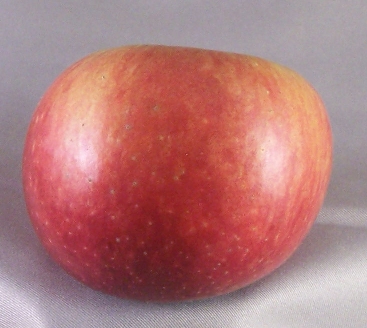
☺Liberty
New York, USA 1966
Considered the most disease-resistant apple in the world, Liberty
is a product of the New York State Agricultural Experiment Station
at Geneva fruit breeding program. The beautiful apple with a sweet,
spicy flavor comes from an extremely productive tree. Although best
eaten fresh, Liberty does store well for several months, and then
makes an excellent pie. Ripens over a long time and is self-fertile. |
|
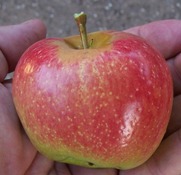 Mollie's Delicious
New York, 1966
Unrelated to the accursed Red Delicious, Mollie's Delicious is an
excellent apple for hot climates, a cross between Golden Delicious
and Red Gravenstein. Sweet, firm, crisp, and aromatic but with not
much acid. Has a beautiful red blush over yellow. Pollinator
required: Fuji, or Granny Smith; ripens mid-season, stays crisp in
the heat, keeps rather well, supposedly improves after a month in
storage. Mollie's Delicious
New York, 1966
Unrelated to the accursed Red Delicious, Mollie's Delicious is an
excellent apple for hot climates, a cross between Golden Delicious
and Red Gravenstein. Sweet, firm, crisp, and aromatic but with not
much acid. Has a beautiful red blush over yellow. Pollinator
required: Fuji, or Granny Smith; ripens mid-season, stays crisp in
the heat, keeps rather well, supposedly improves after a month in
storage. |
|
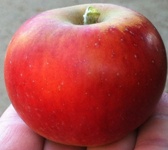 ☺Red
Rebel
Virginia, USA 1850 This beautiful apple originated in
Rappahannock, Virginia on the farm of Captain Charles B. Wood. It
was once described in old nursery catalogs as "the prettiest apple
that grows." Despite its attractiveness and fine flavor, the apple
never gained a following in the American South and was thought to be
lost until apple hunter Joyce Neighbors of Gadsden, Alabama, found
an old tree growing in nearby Wedowee which had been planted in the
1930's. Thanks to her efforts, this wonderful old apple is once
again available. The apple is medium to large with deep dark red
skin over a light yellow background. The yellowish flesh is crisp
with a fine sweet-tart flavor. Ripens late season. ☺Red
Rebel
Virginia, USA 1850 This beautiful apple originated in
Rappahannock, Virginia on the farm of Captain Charles B. Wood. It
was once described in old nursery catalogs as "the prettiest apple
that grows." Despite its attractiveness and fine flavor, the apple
never gained a following in the American South and was thought to be
lost until apple hunter Joyce Neighbors of Gadsden, Alabama, found
an old tree growing in nearby Wedowee which had been planted in the
1930's. Thanks to her efforts, this wonderful old apple is once
again available. The apple is medium to large with deep dark red
skin over a light yellow background. The yellowish flesh is crisp
with a fine sweet-tart flavor. Ripens late season. |
|
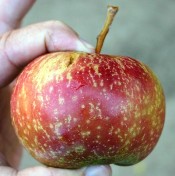 ☺Reverend Morgan
Texas, 1965 A local family
heirloom of the Deep South, originating in Houston, Texas, an area known
more for cattle, rice, and sugar cane than apples. The apple was
first raised by Reverend Herman T. Morgan in 1965 from seeds of
Granny Smith and produced its first fruit in 1972. It is well
adapted to tropic conditions and does well wherever it's tried. Fruit is
medium to large, roundish-conical with rich pinkish-red skin. A fine
quality apple that ripens in late in the season. ☺Reverend Morgan
Texas, 1965 A local family
heirloom of the Deep South, originating in Houston, Texas, an area known
more for cattle, rice, and sugar cane than apples. The apple was
first raised by Reverend Herman T. Morgan in 1965 from seeds of
Granny Smith and produced its first fruit in 1972. It is well
adapted to tropic conditions and does well wherever it's tried. Fruit is
medium to large, roundish-conical with rich pinkish-red skin. A fine
quality apple that ripens in late in the season. |
|
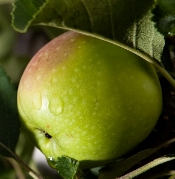 Shell
of Alabama
Alabama,
late 1800ís
Originating in
the USA southern state of
Alabama, this was developed by Mr. Green Shell (born 1841). Mr. Shell had an
apple orchard in the warm climate of Escambia County, and developed an
industry around this apple, shipping boxcars of crisp, somewhat
tart, green apples north in July before other apples were ripe.
We're recommending it as a companion to Anna and Dorsett Golden, as
it blossoms and ripens with them and is their equal in vigor and
much superior to the detestable Ein Shemer, a terrible apple which
used to be though of as a pollinator for Anna. Shell
of Alabama
Alabama,
late 1800ís
Originating in
the USA southern state of
Alabama, this was developed by Mr. Green Shell (born 1841). Mr. Shell had an
apple orchard in the warm climate of Escambia County, and developed an
industry around this apple, shipping boxcars of crisp, somewhat
tart, green apples north in July before other apples were ripe.
We're recommending it as a companion to Anna and Dorsett Golden, as
it blossoms and ripens with them and is their equal in vigor and
much superior to the detestable Ein Shemer, a terrible apple which
used to be though of as a pollinator for Anna. |
|
 Sierra
Beauty California, USA, 1890 A byproduct of the
California gold-rush era, Sierra Beauty was discovered as a seedling high in the
Sierra Nevada mountains. Offered by nurseries for a few years, it became extinct except
as an heirloom of the Gowan Family of Philo (Mendocino County) until
"rediscovered" around 1980. Tends toward biannual bearing, so thin
heavily for more consistent crops. A beautiful apple with
striking appearance, firm texture, and is very tart until
fully ripe when it has an intense sweet-tart flavor that begs for
another bite. Ripens late in the season. Sierra
Beauty California, USA, 1890 A byproduct of the
California gold-rush era, Sierra Beauty was discovered as a seedling high in the
Sierra Nevada mountains. Offered by nurseries for a few years, it became extinct except
as an heirloom of the Gowan Family of Philo (Mendocino County) until
"rediscovered" around 1980. Tends toward biannual bearing, so thin
heavily for more consistent crops. A beautiful apple with
striking appearance, firm texture, and is very tart until
fully ripe when it has an intense sweet-tart flavor that begs for
another bite. Ripens late in the season. |
|
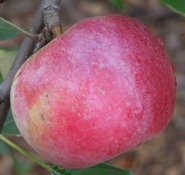 Terry
Winter
Georgia, USA, 1850ís An excellent old southern
apple noted for its long-keeping abilities for warm winter areas. It
originated before the American Civil War with a Mr. Terry of Fulton
County, Georgia, and was soon widely sold throughout Georgia and
neighboring states. Medium-sized fruit with thick, tough yellow skin
covered with stripes and splashes of red and crimson. The white
flesh is crisp, sweet/tart and juicy. This is one of the most
prolific varieties we have, setting a huge crop the second year.
Make sure to thin heavily for the best quality. Ripens
late in the season
over a long period. Terry
Winter
Georgia, USA, 1850ís An excellent old southern
apple noted for its long-keeping abilities for warm winter areas. It
originated before the American Civil War with a Mr. Terry of Fulton
County, Georgia, and was soon widely sold throughout Georgia and
neighboring states. Medium-sized fruit with thick, tough yellow skin
covered with stripes and splashes of red and crimson. The white
flesh is crisp, sweet/tart and juicy. This is one of the most
prolific varieties we have, setting a huge crop the second year.
Make sure to thin heavily for the best quality. Ripens
late in the season
over a long period. |
|
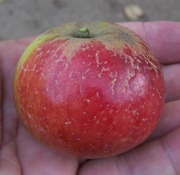 Tompkins
County King
New York, 1804
A large apple with a yellow skin is flushed a
pale-red with darker red stripes and white or russet dots. The yellow flesh is coarse, crisp, and tender, with a
sweet/tart and
aromatic flavor. Vigorous and spreading, the tree grows naturally small. The limbs
grow nearly horizontal with many crossing branches. A pollen sterile
triploid, it will not pollinate other trees or itself. it has a tendency to watercore,
where the flesh becomes translucent and very sweet. Ripens
very late in the season; hangs on the tree until it's past its
prime, so keep an eye on it. Tompkins
County King
New York, 1804
A large apple with a yellow skin is flushed a
pale-red with darker red stripes and white or russet dots. The yellow flesh is coarse, crisp, and tender, with a
sweet/tart and
aromatic flavor. Vigorous and spreading, the tree grows naturally small. The limbs
grow nearly horizontal with many crossing branches. A pollen sterile
triploid, it will not pollinate other trees or itself. it has a tendency to watercore,
where the flesh becomes translucent and very sweet. Ripens
very late in the season; hangs on the tree until it's past its
prime, so keep an eye on it. |
|
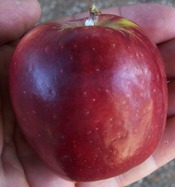 ☺Williams'
Pride
Indiana, 1985 A
product of the Purdue, Rutgers, and University of Illinois (PRI)
breeding program of disease-resistant apples, Williams' Pride is
field immune to scab and cedar apple rust and highly resistant to
fireblight, moderately resistant to powdery mildew. Despite very
warm nights it still develops a deep red color, approaching purple.
It ripens in hot weather and is amazing for the quality the golden
yellow, crisp, juicy, spicy flesh attains, keeping quite well for a
early-season apple It bears early and heavily even on vigorous
rootstocks. The tree has a good growth habit with wide branch angles
and lots of spurs to bear heavily. ☺Williams'
Pride
Indiana, 1985 A
product of the Purdue, Rutgers, and University of Illinois (PRI)
breeding program of disease-resistant apples, Williams' Pride is
field immune to scab and cedar apple rust and highly resistant to
fireblight, moderately resistant to powdery mildew. Despite very
warm nights it still develops a deep red color, approaching purple.
It ripens in hot weather and is amazing for the quality the golden
yellow, crisp, juicy, spicy flesh attains, keeping quite well for a
early-season apple It bears early and heavily even on vigorous
rootstocks. The tree has a good growth habit with wide branch angles
and lots of spurs to bear heavily. |
| |
|
These are just the apple varieties we've picked
out for the tropics for you to start out with; choosing this list
was like trying to choose among your children. We have also
prepared a list of more apples
that could just have easily made this list, and we will have these
available as custom-grafted orders.
We have many more varieties on hand and
hundreds more we can order; if you have your heart set on something
we can usually custom-graft it for you. Who knows, maybe your
selection will do well in the tropics and start a whole industry. |
| |
|
Home |
Order Form |
Contact Us |
|
© 2018 Kuffel Creek |
| |
| |
| |
| |
 ☺GoldRush
Illinois, 1972 Another
product of the PRI disease-resistant breeding
program, GoldRush is immune to scab and highly resistant to powdery
mildew. It is rated tops in both flavor and keeping abilities,
and is said to actually improve in storage. We have found the
tree to be productive and well-adapted to a warm climate. The
crisp, juicy flesh is like a cross between Fuji and Winesap, having
a complexity to go along with high levels of sugar and acid.
☺GoldRush
Illinois, 1972 Another
product of the PRI disease-resistant breeding
program, GoldRush is immune to scab and highly resistant to powdery
mildew. It is rated tops in both flavor and keeping abilities,
and is said to actually improve in storage. We have found the
tree to be productive and well-adapted to a warm climate. The
crisp, juicy flesh is like a cross between Fuji and Winesap, having
a complexity to go along with high levels of sugar and acid. Hunge
North Carolina, 1700's A vigorous grower,
well-adapted to zero-chill warm climates in East Africa. The
crisp, juicy flesh is intensely sweet-tart, overwhelming at first,
but becoming more tolerable on the second bite with a winey flavor.
It is also excellent dried and cooked. Ripens mid-season,
about 6-8 weeks after Anna.
Hunge
North Carolina, 1700's A vigorous grower,
well-adapted to zero-chill warm climates in East Africa. The
crisp, juicy flesh is intensely sweet-tart, overwhelming at first,
but becoming more tolerable on the second bite with a winey flavor.
It is also excellent dried and cooked. Ripens mid-season,
about 6-8 weeks after Anna. 
 ☺Aunt
Rachel
☺Aunt
Rachel ☺Bramley
England, 1800 Bramley is the national cooking apple of
England and many will find it odd for it to be on this list, but it
has proven to be very reliable in a tropic climate. It is very
vigorous (the original 200-year-old tree is still growing and
bearing apples in Nottingham) and annual bearing. It is quite
tart until completely ripe and makes an applesauce that will about
blow your head off with an intense flavor. Resistant to scab
and powdery mildew. For an apple from
such a cool climate it sure is not bothered by the heat any,
tolerating 45 C. with no problems.
☺Bramley
England, 1800 Bramley is the national cooking apple of
England and many will find it odd for it to be on this list, but it
has proven to be very reliable in a tropic climate. It is very
vigorous (the original 200-year-old tree is still growing and
bearing apples in Nottingham) and annual bearing. It is quite
tart until completely ripe and makes an applesauce that will about
blow your head off with an intense flavor. Resistant to scab
and powdery mildew. For an apple from
such a cool climate it sure is not bothered by the heat any,
tolerating 45 C. with no problems.  Dixie
Red Delight
Alabama, 1960ís A sport of Red
Delight of the early 1900's, Dixie Red Delight was developed by
an amateur horticulturist, Oren T. Bolding, of Sylacauga, Alabama.
Fruit is medium to large, with red skin and yellow ground color.
Flavor is sharp, sweet, aromatic, and spicy, and improves in
storage; the closest thing to Virginia Winesap we've tasted in a hot
climate. Keeps well and improves in storage, bears heavily and
reliably, ripens late in the season and blooms late.
Dixie
Red Delight
Alabama, 1960ís A sport of Red
Delight of the early 1900's, Dixie Red Delight was developed by
an amateur horticulturist, Oren T. Bolding, of Sylacauga, Alabama.
Fruit is medium to large, with red skin and yellow ground color.
Flavor is sharp, sweet, aromatic, and spicy, and improves in
storage; the closest thing to Virginia Winesap we've tasted in a hot
climate. Keeps well and improves in storage, bears heavily and
reliably, ripens late in the season and blooms late.
 Dorset Golden
Bahamas, 1954
Bred by Mrs. I. Dorsett in Nassau as a chance seedling of Golden
Delicious. The best pollinator for Anna and an excellent apple
in it's own right, as it will grow anywhere and produces the year
after planting. Like Anna it can be coaxed to bear two crops per
year. Crunchy, juicy, sweet-tart with classic apple flavor. Good
fresh, in pies, and for cider. They start to fall off the tree when
ripe, and the flavor is best when just a little green still.
Thin hard to obtain huge apples. When pollinated correctly
with Anna the apples have a distinct "blockish" shape. They
bruise easily.
Dorset Golden
Bahamas, 1954
Bred by Mrs. I. Dorsett in Nassau as a chance seedling of Golden
Delicious. The best pollinator for Anna and an excellent apple
in it's own right, as it will grow anywhere and produces the year
after planting. Like Anna it can be coaxed to bear two crops per
year. Crunchy, juicy, sweet-tart with classic apple flavor. Good
fresh, in pies, and for cider. They start to fall off the tree when
ripe, and the flavor is best when just a little green still.
Thin hard to obtain huge apples. When pollinated correctly
with Anna the apples have a distinct "blockish" shape. They
bruise easily.  ☺Dula's
Beauty
North Carolina, USA late 1800's Originated from seeds of a
Limbertwig planted by J. A. Dula of Lenoir, North Carolina. It
is a strong, vigorous tree well adapted to all growing conditions.
In 1908, the NC Dept. of Agriculture recommended this variety for
lowland coastal growers (a very warm climate). Fruit is large and
slightly conical with dark-red skin overlaid with darker red
stripes. Flesh is yellowish-white, tender, crisp and juicy. Ripens
late fall to early winter, good disease resistance.
☺Dula's
Beauty
North Carolina, USA late 1800's Originated from seeds of a
Limbertwig planted by J. A. Dula of Lenoir, North Carolina. It
is a strong, vigorous tree well adapted to all growing conditions.
In 1908, the NC Dept. of Agriculture recommended this variety for
lowland coastal growers (a very warm climate). Fruit is large and
slightly conical with dark-red skin overlaid with darker red
stripes. Flesh is yellowish-white, tender, crisp and juicy. Ripens
late fall to early winter, good disease resistance. Lady Williams
Australia, 1935 A Granny Smith offspring
that is also a parent of Pink Lady. A pinkish-red apple with a
distinctive horizontal white stripe on one side that ripens very
late and needs a long hot season, usually ripening two months later than
most other apples.
It is quite tart until fully ripe, when it developed a nice sweet/tart
balance. So far it has out-produced its offspring Cripp's Pink (aka
Pink Lady) and is grown in the jungles of Malaysia with good
success.
Lady Williams
Australia, 1935 A Granny Smith offspring
that is also a parent of Pink Lady. A pinkish-red apple with a
distinctive horizontal white stripe on one side that ripens very
late and needs a long hot season, usually ripening two months later than
most other apples.
It is quite tart until fully ripe, when it developed a nice sweet/tart
balance. So far it has out-produced its offspring Cripp's Pink (aka
Pink Lady) and is grown in the jungles of Malaysia with good
success. Mollie's Delicious
New York, 1966
Unrelated to the accursed Red Delicious, Mollie's Delicious is an
excellent apple for hot climates, a cross between Golden Delicious
and Red Gravenstein. Sweet, firm, crisp, and aromatic but with not
much acid. Has a beautiful red blush over yellow. Pollinator
required: Fuji, or Granny Smith; ripens mid-season, stays crisp in
the heat, keeps rather well, supposedly improves after a month in
storage.
Mollie's Delicious
New York, 1966
Unrelated to the accursed Red Delicious, Mollie's Delicious is an
excellent apple for hot climates, a cross between Golden Delicious
and Red Gravenstein. Sweet, firm, crisp, and aromatic but with not
much acid. Has a beautiful red blush over yellow. Pollinator
required: Fuji, or Granny Smith; ripens mid-season, stays crisp in
the heat, keeps rather well, supposedly improves after a month in
storage. ☺Red
Rebel
☺Red
Rebel Shell
of Alabama
Shell
of Alabama  Sierra
Beauty California, USA, 1890 A byproduct of the
California gold-rush era, Sierra Beauty was discovered as a seedling high in the
Sierra Nevada mountains. Offered by nurseries for a few years, it became extinct except
as an heirloom of the Gowan Family of Philo (Mendocino County) until
"rediscovered" around 1980. Tends toward biannual bearing, so thin
heavily for more consistent crops. A beautiful apple with
striking appearance, firm texture, and is very tart until
fully ripe when it has an intense sweet-tart flavor that begs for
another bite. Ripens late in the season.
Sierra
Beauty California, USA, 1890 A byproduct of the
California gold-rush era, Sierra Beauty was discovered as a seedling high in the
Sierra Nevada mountains. Offered by nurseries for a few years, it became extinct except
as an heirloom of the Gowan Family of Philo (Mendocino County) until
"rediscovered" around 1980. Tends toward biannual bearing, so thin
heavily for more consistent crops. A beautiful apple with
striking appearance, firm texture, and is very tart until
fully ripe when it has an intense sweet-tart flavor that begs for
another bite. Ripens late in the season. Tompkins
County King
New York, 1804
A large apple with a yellow skin is flushed a
pale-red with darker red stripes and white or russet dots. The yellow flesh is coarse, crisp, and tender, with a
sweet/tart and
aromatic flavor. Vigorous and spreading, the tree grows naturally small. The limbs
grow nearly horizontal with many crossing branches. A pollen sterile
triploid, it will not pollinate other trees or itself. it has a tendency to watercore,
where the flesh becomes translucent and very sweet. Ripens
very late in the season; hangs on the tree until it's past its
prime, so keep an eye on it.
Tompkins
County King
New York, 1804
A large apple with a yellow skin is flushed a
pale-red with darker red stripes and white or russet dots. The yellow flesh is coarse, crisp, and tender, with a
sweet/tart and
aromatic flavor. Vigorous and spreading, the tree grows naturally small. The limbs
grow nearly horizontal with many crossing branches. A pollen sterile
triploid, it will not pollinate other trees or itself. it has a tendency to watercore,
where the flesh becomes translucent and very sweet. Ripens
very late in the season; hangs on the tree until it's past its
prime, so keep an eye on it. 